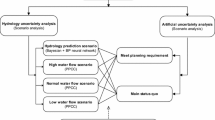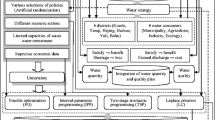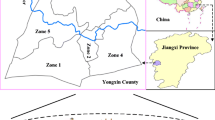Abstract
The Shiyanghe river basin, an arid inland basin of northwest China, is taken as an example to analyze the risk for achieving the ecological planning objective in arid inland river basins under uncertainty conditions. Hydrology and management uncertainties that affect the accomplishment of ecological planning objective are analyzed quantitatively with the methods of Bayesian theory based Probabilistic model, scenario analysis and interval analysis. Bayesian probabilistic analysis method was used to analyze the hydrological uncertainties in the form of probability and interval distributions in planning period, while the scenario analysis method and interval method were used to analyze the managing uncertainties in the form of interval numbers. Instead of the ecological risk analysis, which for arid inland river basin, of studying the impact of environmental and human factor on ecological system, water resources and environment, we focused on analysing the possible impact of hydrological and management uncertainty factor on the ecological planning, and forecasting the degree of the completion under the uncertainty. Our study provided the probabilities of achieving ecological planning objective and the possible deviation of different scenarios. The more local water resources and higher level of local water resource utilization and management appeared to lead higher probability to achieve the ecological objective. This study can help environment and water resource managers and planner to formulate a rational planning for arid inland river basins under hydrological and management uncertainty.







Similar content being viewed by others
References
Bao C, Fang C, Chen F (2006) Mutual optimization of water utilization structure and industrial structure in arid inland river basins of Northwest China. J Geogr Sci 16(1):87–98
Buytaert W, Friesen J, Liebe J, Ludwig R (2012) Assessment and management of water resources in developing, semi-arid and arid regions. Water Resour Manag 26(4):841–844
Campolo M, Soldati A, Andreussi P (2003) Artificial neural network approach to flood forecasting in the River Arno. Hydrol Sci J 48(3):381–398
Chen C-S, Chen BP-T, Chou FN-F, Yang C-C (2010) Development and application of a decision group back-propagation neural network for flood forecasting. J Hydrol 385(1):173–182
Chua LH, Wong TS (2011) Runoff forecasting for an asphalt plane by artificial neural networks and comparisons with kinematic wave and autoregressive moving average models. J Hydrol 397(3):191–201
Cornish E (2004) Futuring: the exploration of the future. World Future Society
Davies BR, Thoms M, Meador M (1992) An assessment of the ecological impacts of inter-basin water transfers, and their threats to river basin integrity and conservation. Aquat Conserv Mar Freshwat Ecosyst 2(4):325–349
Fraedrich K, Sielmann F, Cai D, Zhang L, Zhu X (2015) Validation of an ideal rainfall-runoff chain in a GCM environment. Water Resour Manag 29(2):313–324
Gottardo S, Semenzin E, Giove S, Zabeo A, Critto A, Zwart D, Ginebreda A, Marcomini A (2011) Integrated risk assessment for WFD ecological status classification applied to Llobregat river basin (Spain). Part I—fuzzy approach to aggregate biological indicators. Sci Total Environ 409(22):4701–4712
Gu J, Guo P, Huang G (2015) Achieving the objective of ecological planning for arid inland river basin under uncertainty based on ecological risk assessment. Stoch Env Res Risk A. doi:10.1007/s00477-015-1159-5
Hansen E (1965) Interval arithmetic in matrix computations, Part I. J Soc Ind Appl Math Ser B Numer Anal 2(2):308–320
Hope BK (2006a) An examination of ecological risk assessment and management practices. Environ Int 32(8):983–995
Hope BK (2006b) An assessment of anthropogenic source impacts on mercury cycling in the Willamette Basin, Oregon, USA. Sci Total Environ 356(1–3):165–191
Hsin-Ting SU, Tung YK (2014) Comparisons of risk-based decision rules for the application of water resources planning and management. Water Resour Manag 28(12):3921–3935
Hunt J, Birch G, Warne MSJ (2010) Site‐specific probabilistic ecological risk assessment of a volatile chlorinated hydrocarbon‐contaminated tidal estuary. Environ Toxicol Chem 29(5):1172–1181
Jarke M, Bui XT, Carroll JM (1998) Scenario management: an interdisciplinary approach. Requir Eng 3(3–4):155–173
Ji X, Kang E, Chen R, Zhao W, Zhang Z, Jin B (2006) The impact of the development of water resources on environment in arid inland river basins of Hexi region, Northwestern China. Environ Geol 50(6):793–801
Karvetski CW, Lambert JH, Linkov I (2011a) Scenario and multiple criteria decision analysis for energy and environmental security of military and industrial installations. Integr Environ Assess Manag 7(2):228–236
Karvetski CW, Lambert JH, Keisler JM, Linkov I (2011b) Integration of decision analysis and scenario planning for coastal engineering and climate change. IEEE Trans Syst Man Cybern Syst Hum 41(1):63–73
Korteling B, Dessai S, Kapelan Z (2013) Using information-gap decision theory for water resources planning under severe uncertainty. Water Resour Manag 27(4):1149–1172
Krzysztofowicz R (1985) Bayesian models of forecasted time series 1. JAWRA J Am Water Resour Assoc 21(5):805–814
Krzysztofowicz R (1999) Bayesian theory of probabilistic forecasting via deterministic hydrologic model. Water Resour Res 35(9):2739–2750
Krzysztofowicz R (2002) Bayesian system for probabilistic river stage forecasting. J Hydrol 268(1):16–40
Krzysztofowicz R, Kelly KS (2000) Hydrologic uncertainty processor for probabilistic river stage forecasting. Water Resour Res 36(11):3265–3277
Liu HL, Bao AM, Pan XL, Chen X (2013) Effect of land-use change and artificial recharge on the groundwater in an Arid inland river basin. Water Resour Manag 27(10):3775–3790
Loukachine K, Loeb NG (2003) Application of an artificial neural network simulation for top-of-atmosphere radiative flux estimation from CERES. J Atmos Ocean Technol 20(12):1749–1757
Ma Z, Li Z, Zhang M, Fan Z (2013) Bayesian statistic forecasting model for middle-term and long-term runoff of a hydropower station. J Hydrol Eng 18(11):1458–1463
Marianne KCS, Antoni G, Susana G, Jose Luis C, Miren López DA, Damià B (2012) Analysis of the occurrence and risk assessment of polar pesticides in the Llobregat River Basin (NE Spain). Chemosphere 86(1):8–16
Martin-Carrasco F, Garrote L, Iglesias A, Mediero L (2013) Diagnosing causes of water scarcity in complex water resources systems and identifying risk management actions. Water Resour Manag 27(6):1693–1705
Moore RE (1962) Interval arithmetic and automatic error analysis in digital computing, DTIC Document
Moore R, Lodwick W (2003) Interval analysis and fuzzy set theory. Fuzzy Sets Syst 135(1):5–9
Norton SB, Rodier DJ, van der Schalie WH, Wood WP, Slimak MW, Gentile JH (1992) A framework for ecological risk assessment at the EPA. Environ Toxicol Chem 11(12):1663–1672
Ren M, Wang B, Liang Q, Fu G (2010) Classified real-time flood forecasting by coupling fuzzy clustering and neural network. Int J Sediment Res 25(2):134–148
Samuel JM, Sivapalan M (2008) Effects of multiscale rainfall variability on flood frequency: comparative multisite analysis of dominant runoff processes. Water Resour Res 44(9):542–547
Schwartz P (1996) The art of the long view: planning for the future in an uncertain world. author: Peter Schwartz, Publisher: Currency Doubl
Suter I, Glenn W (2001) Applicability of indicator monitoring to ecological risk assessment. Ecol Indic 1(2):101–112
Taguas EV, Gómez JA, Denisi P, Mateos L (2015) Modelling the rainfall-runoff relationships in a large olive orchard catchment in southern Spain. Water Resour Manag 29:1–15
Tayfur G, Brocca L (2015) Fuzzy logic for rainfall-runoff modelling considering soil moisture. Water Resour Manag in press 1–15
Üreyen ME, Gürkan P (2008) Comparison of artificial neural network and linear regression models for prediction of ring spun yarn properties. I. Prediction of yarn tensile properties. Fibers Polym 9(1):87–91
Varum CA, Melo C (2010) Directions in scenario planning literature–a review of the past decades. Futures 42(4):355–369
Wu S, Li J, Huang GH (2008) Characterization and evaluation of elevation data uncertainty in water resources modeling with GIS. Water Resour Manag 22(8):959–972
Xiao Z, Chen W, Li L (2013) A method based on interval-valued fuzzy soft set for multi-attribute group decision-making problems under uncertain environment. Knowl Inf Syst 34(3):653–669
Zhang X, Zhao K (2012) Bayesian neural networks for uncertainty analysis of hydrologic modeling: a comparison of two schemes. Water Resour Manag 26(8):2365–2382
Zhang X, Xu K, Zhang D (2012) Risk assessment of water resources utilization in Songliao Basin of Northeast China. Environ Earth Sci 67(5):1319–1329
Zhang L, Nan Z, Yu W, Ge Y (2015) Modeling land-use and land-cover change and hydrological responses under consistent climate change scenarios in the Heihe River Basin, China. Water Resour Manag
Zhu Y, Wu Y, Drake S (2004) A survey: obstacles and strategies for the development of ground-water resources in arid inland river basins of Western China. J Arid Environ 59(2):351–367
Zhu Z, Bai H, Xu H, Zhu T (2011) An inquiry into the potential of scenario analysis for dealing with uncertainty in strategic environmental assessment in China. Environ Impact Assess Rev 31(6):538–548
Zwart DD, Posthuma L, Gevrey M, Ohe PCVD, Deckere DE (2008) Diagnosis of ecosystem impairment in a multiple-stress context—how to formulate effective river basin management plans. Integr Environ Assess Manag 5(1):38–49
Acknowledgments
This study was supported by the National Natural Science Foundation of China (No. 41271536), it is also supported by both the Fundamental Research Funds for the Central Universities (No. JZ2014HGBZ0324) and the Research Fund Project of Hefei University of Technology (No. JZ2015HGXJ0166).
Author information
Authors and Affiliations
Corresponding author
Appendix
Appendix
Rights and permissions
About this article
Cite this article
Gu, J., Li, M., Guo, P. et al. Risk Assessment for Ecological Planning of Arid Inland River Basins Under Hydrological and Management Uncertainties. Water Resour Manage 30, 1415–1431 (2016). https://doi.org/10.1007/s11269-016-1230-0
Received:
Accepted:
Published:
Issue Date:
DOI: https://doi.org/10.1007/s11269-016-1230-0




